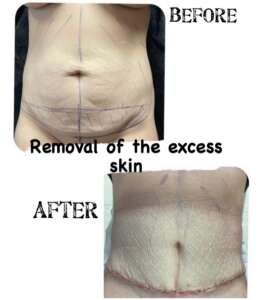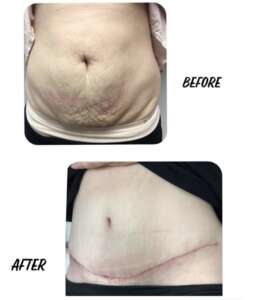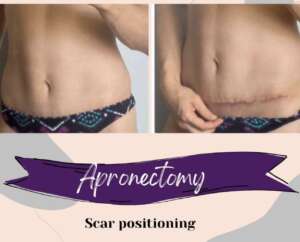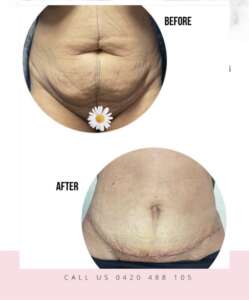APRONECTOMY – EXCISION OF THE TUMMY EXCESS SKIN.
Apronectomy, more commonly known as excision of the excess skin of the tummy, is a procedure performed to remove sagging skin and excess fat from the lower abdomen. The unwanted protrusion of the abdomen and hanging apron is usually a result of pregnancy, an increase in weight, or weight loss. Apronectomy is a procedure that can be performed both for men and women.
LAYERS OF THE ABDOMINAL WALL:
There are two layers to the abdominal wall that need to be corrected in an apronectomy;
• the skin,
• and the fatty tissue.
All of these layers, at some stages, are stretched, weakened, or increased in size, resulting in an undesirable appearance. In many cases, the skin stretches so much that they do not return to normal regardless of the amount of diet and exercise. An apronectomy can make an enormous change to a person’s body contour.
AM I A CANDIDATE FOR THE APRONECTOMY?
An excision of the skin on the tummy may be a good option for you if you:
• Desire improvement of skin and muscle laxity in the abdominal area.
• Are physically healthy and at a stable weight.
• Have realistic expectations.
• Are a non-smoker or have stopped smoking or will stop smoking during the procedure and the entire recovery period.
Apronectomy, or excision of the excess skin of the tummy, is a highly individualized procedure and, as such, may not be suitable for everyone. It is a very personal decision, and you should have realistic goals and expectations before undergoing the procedure.
Excision of the excess skin of the tummy is not suitable for people who cannot have anesthetic, are prone to bleeding, have poor healing ability, or are too high of a risk for procedural complications. Apronectomy is not a substitute for weight loss or an appropriate exercise program. Keep in mind that while the results of excision of the excess skin of the tummy are technically permanent, the positive outcome can be greatly diminished by significant fluctuations in your weight. For that reason, you may be asked to consider delaying the procedure if you are still in the process of losing weight or if you are planning on having more children.
Your goals, expectations, and an understanding of achievable results are most important, and these will also be discussed during your consultation.
WHY IS APRONECTOMY BEING PERFORMED?
Apronectomy is typically performed for changes to the belly that have occurred through pregnancy and/or weight loss. The usual problems are stretch marks (scars caused by skin that has been forced to stretch too much too quickly), excess skin, and excess fatty tissue.
Hernia repairs, muscle separations, and muscle tightening are not performed in the Apronsectomy procedure. If you are concerned about these, then abdominoplasty is the procedure that will benefit you.
Finally, problems with the pubic area frequently exist with excess fullness and hanging. This typically causes difficulties with tight-fitting clothing, social embarrassment, and hygiene problems.
All these problems can be improved/corrected with a well-planned excision of the excess skin. The excess skin can be removed, including most, if not all, the stretch marks. Doing this means removing all the stretch mark scars that you can’t hide and creating a single scar below your pantsline that can be comfortably hidden.
INITIAL CONSULTATION
You will be needing a GP referral to come for a consultation. Firstly, upon arriving at our clinic you will be met by our friendly staff and they will walk you through the initial patient registration process. Once this is done, you will be ready to be taken through your initial consultation with Dr Ali Hussain.
During this consultation, you will be asked a number of questions, including about your relevant medical background, history of procedure, especially apronectomy procedure, and your general tummy concerns, followed by the physical examination to assess the belly, skin quality, fat, and muscles.
Once you are assessed, and if you are considered suitable for the procedure, then a procedural plan is created to provide you with the desired outcome. Of course, an important part of this is ensuring you have a realistic expectation about the results achievable.
Dr Ali Hussain will advise you the details of the procedure, your expected recovery period and inform you about the potential risks and complications that allow you to make an informed decision. Photos are then taken for our medical records.
If you are planning to have more children, you should discuss this with Dr Ali Hussain at your consultation; however, it is advisable to wait until after you have completed your family to have this procedure.
Dr Ali Hussain will offer you a secondary complimentary consultation to answer any additional questions you have following your initial consultation. It is important that you have a thorough understanding of your planned procedure.
WILL I HAVE VISIBLE APRONECTOMY SCARS?
Apronectomy incisions are generally made on the bikini line, but this can vary. An incision stretching from hip to hip is made low on the abdomen, in a location that should be hidden under swimwear and underwear. Initially, after the procedure, the scars are typically reddish in color, but they should fade in time to light pink, and after one or two years, the scars become barely noticeable. In our experience, most of our patients believe that the aesthetic results of the procedure are well worth the resulting scar.
Very rarely, bad scars happen which are called keloid and hypertrophic scars. If scarring is a concern for you after procedure, Dr Ali Hussain will provide you with a scar treatment plan to expedite the healing of your scars. There are several treatment options, which will be personalized to your situation.
HOW IS THE APRONECTOMY PROCEDURE PERFORMED?
You will have at least two consultations with Dr Ali Hussain before the procedure, and he can answer specific questions about what to expect after your procedure. Be sure to ask questions to ensure that you go into this procedure feeling comfortable and with realistic expectations. Dr Ali Hussain will give you specific instructions on post-operative care before your procedure. These instructions may include:
• How to care for the procedural site
• Specific concerns to look for at the procedural site or in your general health
• When to follow-up with your doctor
Apronectomy is performed under tumescent anesthesia with minimal sedation for a quick recovery. The procedure can take between one to two hours to complete, depending on which procedural technique is used and the complexity of your case.
During the procedure, and depending on the details of your treatment plan, Dr Ali Hussain will create an incision along the lower abdomen to access the foundational structures, fatty tissue removed via liposuction, and excess skin trimmed away. The incision will be closed, and dressings will be applied.
WHAT CAN I EXPECT DURING RECOVERY FROM APRONECTOMY?
Recovery time will vary from patient to patient and will also depend on the extent of the procedure. But expect at least two weeks off work to allow for complete rest and another one week for the majority of visible swelling and bruising to disappear. Light exercise may be resumed within two to three weeks, but strenuous exercise should be avoided for at least two to three months. You will be given post-procedure instructions, and if you have any questions, please ask Dr Ali Hussain.
Following your procedure, dressings or bandages may be applied to your incisions. You may be wrapped in an elastic bandage or a compression garment to minimise swelling and to support your abdomen as it heals. A drain dressing may also be temporarily placed under the garment to drain any excess blood or fluid that may collect if necessary.
APRONECTOMY
Many people often enquire about an apronectomy. The first thing to realise is that only a small group of men and women would benefit from an apronectomy.
The apronectomy procedure is only suitable for those few women and men who have a little bit of loose skin in the lower abdominal area – just above the pubic level. The apronectomy procedure basically removes this excess and loose skin at the very lower abdomen, above the pubic area.
The scar is often not much larger that a caesarean scar, the belly button is “moved”, but not replaced and it is typically a day procedure and usually not associated with any muscle tightening. After the procedure, it is recommended to do exercises to strengthen the muscles for better results. It is essential to talk to our doctor to see if apronectomy is right for you and to understand what to expect from the procedure.
POST-PROCEDURAL RESULTS AND EXPECTATIONS
One common myth about the apronectomy procedure is that you are going to achieve a six-pack after the procedure. After undergoing an apronectomy procedure, it is important to have realistic expectations about the results.
The apronectomy procedure is mainly about removing excess skin and fat and shaping your body contours to better match your underlying natural body.
Getting a six-pack requires having well- formed and defined six pack muscles and low body fat. If you don’t already have these things before the procedure, you won’t magically get them afterward.
Also, the amount of fat left after the surgery will be similar to the rest of your body. So, if you had a high body fat percentage before the procedure, it won’t drastically change afterward. In other words, if your body fat percentage is not down to a “shredded” state before the procedure, then it won’t be like that after the procedure.
But what’s really impressive about an apronectomy isn’t just the procedure itself—it’s how patients use the transformation as a motivation to adopt healthier lifestyles. By eating better (better diet) and exercising regularly, they can enhance their results and keep improving themselves.
BACK PAIN
Patients who often experience lower back pain due to the significant biomechanical disturbance to the core and back. These patients often claim an improvement in back pain after this is corrected. So, this can be considered an added bonus to having the procedure.
WEIGHT LOSS FOLLOWING PROCEDURE
An important thing to understand is that for the majority of patients, an apronectomy should never be considered a weight loss procedure. An apronectomy is usually performed to remove excess skin that won’t go away with diet and exercise alone.
PREGNANCY FOLLOWING ABDOMINOPLASTY
Most people tend to undergo an apronectomy procedure after they have completed their family, in other words, not planning on having any more children.
Procedure, of course, will not stop you from getting pregnant, and most importantly, it will not prevent your tummy from growing during pregnancy. So, it is not going to complicate future pregnancies, however it may affect the result of the apronectomy.
ON PROCEDURE DAY
You will be provided with information regarding your arrival time at the facility and when to begin fasting a few days prior to the procedure. You will be seen by the facility staff member, who will direct you to the pre-procedural waiting area upon arrival at the facility before Dr Ali Hussain performs their pre-operative checks and answer any final questions. At this point, you will be made comfortable while you wait to be taken into the procedure room. We do our best to ensure that you are advised to come to the facility as close to the scheduled procedure time, however sometimes you may have to wait a little longer than planned before we can start your procedure.
POST-OPERATIVE APPOINTMENTS
After your procedure, you’ll have several follow-up appointments with Dr. Ali Hussain to monitor your progress. These appointments typically occur at 24-48 hours, 1 week, 2 weeks, 6 weeks, 3 months, and 6 months post-surgery. Additional appointments can be arranged upon request or if Dr. Ali deems them necessary, depending on your own personal healing process.
These follow-up appointments are essential for ensuring that your recovery is on track and that you are reaching important milestones in healing and meeting the right recovery.
Many of our patients traveling from out of state to have their procedure, we make provisions and arrangements to stay in touch especially during at the key time points in the recovery process to ensure nothing is missed. If you are visiting Brisbane at any time, simply let our clinic know in advance, and we’ll fit you in.
RECOVERY
In order to better prepare for your procedure and to help with getting back to normal, it’s important to appreciate what you’re going to experience.
What to expect for the first 24 hours:
• You will wake from the procedure in a hospital bed with the head of the bed elevated and one or two pillows under your knees, all designed to keep your hips in a flexed position. This is to ensure you have minimal tension on your procedural wounds.
• All your wounds are stitched up using several layers of internal dissolving sutures.
• All your wounds are covered using waterproof dressings.
• You will have a compression garment applied over the wound.
When you first get up to walk, which we encourage with assistance on the first post-operative day, then you will be hunched over and slowly shuffle along. Don’t try to straighten up because you are feeling tight for a very good reason: your skin has been tightened, and usually, so have your muscles. Of course, those who have not required any muscle tightening are generally far more comfortable but will still feel tight.
As a very rough guide, it takes approximately two weeks before you feel like you can straighten up. Don’t force the issue; it will happen when it wants to happen.
RETURNING TO DRIVING
As a general rule, it takes about two weeks before you can straighten up due to the significant abdominal tightness. Therefore, you refrain from driving during the first two weeks period.
After this time, it is important to use your judgment/common sense should be used. If you feel physically comfortable and mobile enough to get behind the wheel safely, then it’s generally fine to resume driving.
RETURNING TO WORK
Your return to work will vary from patient to patient, however as a general guideline you can consider returning to an office-based job one to two weeks after procedure. More manual and labour intensive jobs should be discussed with Dr Ali during a consultation.
RETURNING TO EXERCISE
Returning to normal physical activity including exercising is important after the procedure. Of course, you will need to understand that apronectomy is a procedure with a sizeable external wound, usually with liposuction.
• After about two weeks once you feel like you can actually stand up straight, feel free to increase the walking distance, but no power walking or running.
• Avoid any physical activities that cause you to strain or activate your core muscles for the first 6-8 weeks.
• At six weeks, you can then slowly return to doing normal training and physical activities. I say slowly because you are definitely not going to be able to do what you want to do and you will still have a reasonable amount of pain and discomfort when you start straining.
Abdominal workouts such as crunches etc are something you probably want to avoid for the first 3 months at least.
Ultimately, there is absolutely no reason why you can’t eventually get back to normal, it just takes time.
SEXUAL ACTIVITY
Sexual activity should be avoided for a minimum of 6 weeks post procedure. It is important to give your body the time to rest and heal.
Many people continue to wear the garment beyond 6 weeks as it tends to provide some control of this swelling. We also recommend you perform gentle daily massage to these areas starting a few weeks after procedure to help control the swelling and facilitate the settling process.
HOW LONG DOES AN APRONECTOMY LAST?
Apronectomy procedure is technically a permanent procedure; however, your lifestyle and habits can modify your results, as can the natural process of aging. Pregnancy and childbirth as well as significant weight gain can alter your abdominal contours, which is why we recommend maintaining a healthy weight and waiting until you have finished building your family to have a tummy tuck. Apronectomy does not inhibit your ability to get pregnant, so should you decide to have another child down the line, this procedure should have no impact on your fertility.
Disclaimer:
Please note that undergoing any surgical or non-surgical procedure involves inherent risks and potential complications. Prior to making a decision, it is strongly recommended that you consult with a qualified healthcare professional who can provide a thorough evaluation and advice based on your individual circumstances.
While every effort is made to ensure the accuracy and reliability of the information provided, the content contained herein should not be considered as a substitute for professional medical advice or diagnosis. The information is intended for general knowledge and educational purposes only.
Results, recovery timelines, and outcomes can vary significantly among patients, and no guarantees or assurances can be made regarding specific results. The before-and-after photos or videos featured are for illustrative purposes and may not represent the exact outcome you will achieve.
Furthermore, it is important to understand that immediate post-procedure results may differ from the final results. Factors such as individual healing abilities, adherence to postoperative instructions, and other unforeseen circumstances can influence the final outcome.
Lastly, any endorsements provided by individuals on our platform are based on their personal experiences and should not be considered as guarantees of the same experience or outcome for others.
To make an informed decision, it is advisable to thoroughly discuss and understand all aspects of the surgical procedure, including the potential risks, benefits, alternatives, and expected outcomes. Your healthcare provider will be able to address any specific concerns or questions you may have and guide you through the decision-making process.
Dr Hussain: Registered Medical practitioner – MED0001643849 (General)





